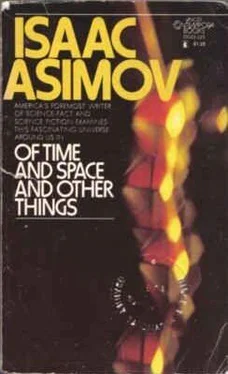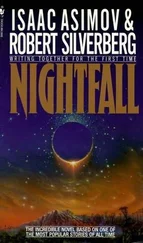Isaac Asimov - Of Time and Space and Other Things
Здесь есть возможность читать онлайн «Isaac Asimov - Of Time and Space and Other Things» весь текст электронной книги совершенно бесплатно (целиком полную версию без сокращений). В некоторых случаях можно слушать аудио, скачать через торрент в формате fb2 и присутствует краткое содержание. Год выпуска: 1972, ISBN: 1972, Издательство: Lancer Books, Жанр: Прочая научная литература, на английском языке. Описание произведения, (предисловие) а так же отзывы посетителей доступны на портале библиотеки ЛибКат.
- Название:Of Time and Space and Other Things
- Автор:
- Издательство:Lancer Books
- Жанр:
- Год:1972
- ISBN:ISBN: 0-447-33023-3
- Рейтинг книги:4 / 5. Голосов: 1
-
Избранное:Добавить в избранное
- Отзывы:
-
Ваша оценка:
- 80
- 1
- 2
- 3
- 4
- 5
Of Time and Space and Other Things: краткое содержание, описание и аннотация
Предлагаем к чтению аннотацию, описание, краткое содержание или предисловие (зависит от того, что написал сам автор книги «Of Time and Space and Other Things»). Если вы не нашли необходимую информацию о книге — напишите в комментариях, мы постараемся отыскать её.
Of Time and Space and Other Things — читать онлайн бесплатно полную книгу (весь текст) целиком
Ниже представлен текст книги, разбитый по страницам. Система сохранения места последней прочитанной страницы, позволяет с удобством читать онлайн бесплатно книгу «Of Time and Space and Other Things», без необходимости каждый раз заново искать на чём Вы остановились. Поставьте закладку, и сможете в любой момент перейти на страницу, на которой закончили чтение.
Интервал:
Закладка:
In physics, particularly, this is the case. There is Modern Physics and there is (with an offhand, patronizing half smile) Classical Physics. To put it into Modern Terrninol ogy, Modern Physics is in, man, in, and Classical Physics is like squaresvhle.
What's more, the division in physics is sharp. Everything after 1900 is Modern; everything before 1900 is Classical.
That looks arbitrary, I admit; a strictly parochial twentieth-century outlook. Oddly enough, though, it is per fectly legitimate. The year 1900 saw a major physical theory entered into the books and nothing has been quite the same since.
By now you have guessed that I am going to tell you about it.
The problem began with German physicist Gustav Robert Kirchhoff who, with Robert Wilhelm Bunsen (popularizer of the Bunsen burner), pioneered in the de velopment of spectroscopy in 1859. Kirchhoff discovered that each element, when brought to incandescence, gave off certain characteristic frequencies of light; and that the vapor of that element, exposed to radiation from a source hotter than itself, absorbed just those frequencies it itself emitted when radiating. In short, a material will absorb those frequencies which, under other conditions, it will radiate; and will radiate those frequencies which, under other conditions, it will absorb.'
But su Ippose that we consider a body which will absorb all frequencies of radiation that fall upon it-absorb them completely. It will then reflect none and will therefore ap pear absolutely black. It is a "black body." Kirchhoff pointed out that such a body, if heated to incandescence, would then necessarily have to radiate all frequencies of radiation' Radiation over a complete range in this manner would be "black-body radiation."
Of course, no body was absolutely black. In the 1890s, however, a German physicist named Wilhelm Wien thought of a rather interesting dodge to get around tiat.
Suppose you had a furnace with a small opening. Any radiation that passes through the opening is either ab sorbed by the rough wall opposite or reflected. The re 175 flected radiation strikes another wall and is again partially absorbed. What is reflected strikes another wall, and so on. Virtually none of the radiation survives to find its way out the small opening again. That small opening, then, absorbs the radiation and, in a manner of speaking, reflects none. It is a black body. If the furnace is heated, the radia tion that streams out of that small opening should be black-body radiation and should, by Kircbhoff's reasoning, contain all frequencies.
Wien proceeded to study the characteristics of this black-body radiation. He found that at any temperature, a wide spread of frequencies was indeed included, but the spread was not an even one. There was a peak in the mid dle. Some intermediate frequency was radiated to a greater extent than other frequencies either higher or lower than that peak frequency. Moreover, as the temperature was increased, this peak was found to move toward the higher frequencies. If the absolute temperature were doubled, the frequency at the peak would also double.
But now the question arose: Why did black-body radia tion distribute itself like this?
To see why the question was puzzling, let's consider infrared light, visible light, and ultraviolet light. The fre quency range of infrared light, to begin with, is from one hundred billion (100,000,000,000) waves per second to four hundred trillion (400,000,000,000,000) waves per second. In order to make the numbers easier to handle, let's divide by a hundred billion and number the frequency not in individual waves per second but in hundred-billion wave packets per second. In that case the range of infrared would be from 1 to 4000.
Continuing to use this system, the range of visible licht would be from 4000 to 8000; and the range of ultraviolet light would be from 8000 to 300,000.
Now it might be supposed that if a black body absorbed all radiation with equal ease, it ought to give off all radia tion with equal case. Whatever its temperature, the energy it had to radiate might be radiated at any frequency, the particular choice of frequency being purely random.
But suppose you were choosing numbers, any numbers with honest radomness, from I to 300,000. If you did this repeatedly, trillions of times, 1.3 per cent of your numbers would be less than 4000; another 1.3 per cent would be between 4000 and 8000 ' and 97.4 per cent would be between 8000 and 300,000.
This is like saying that a black body ought to radiate
1.3 per cent of its energy in the infrared, 1.3 per cent in visible light, and 97.4 per cent in the ultraviolet. If the temperature went up and it had more energy to radiate, it ought to radiate more at every frequency but the relative amounts in each range ought to be unchanged.
And this is only if we confine ourselves to nothing of still higher frequency than ultraviolet. If we include the x-ray frequencies, it would turn out that just about nothing should come off in the visible light at any temperature.
Everything would be in ultraviolet and x-rays.
An English physicist, Lord Rayleigh (1842-1919), worked out an equation which showed exactly this. The radiation emitted by a black body increased steadily as one went up the frequencies. However, in actual practice, a frequency peak was reached after which, at higher fre quencies still, the quantity of radiation decreased again.
Rayleigh's equation was interesting but did not reflect reality.
Physicists referred to this prediction of the Rayleigh equation as the "Violet Catastrophe"-the fact that every body that bad energy to radiate ought to radiate practically all of it in the ultraviolet and beyond.
Yet the whole point is that the Violet Catastrophe does not take place. A radiating body concentrated its radiation in the low frequencies. It radiated chiefly in the infrared at temperatures below, say, 1000' C., and radiated mainly in the visible region even at a temperature as high as
6000' C., the temperature of the solar surface.
Yet Rayleigh's equation was worked out according to the very best principles available anywhere in physical theory-at the time. His work was an ornament of what we now call Classical Physics.
Wien himself worked out an equation which described the frequency distribution of black-body radiation in the bigh-frequency range, but he had no explanation for why it worked there, and besides it only worked for the high frequency range, not for the low-frequency.
Black, black, black was the color of the physics mood all through the later 1890s.
Bt4t then arose in 1899 a champion, a German physicist, Max Karl Ernst Ludwig Planck. He reasoned as fol -lows…
If beautiful equations worked out by impeccable reason ing from highly respected physical foundations do not de scribe the truth as we observe it, then either the reason ing or the physical foundations or both are wrong.
And if there is nothing wrong about the reasoning (and nothing wrong could be found in it), then the physical foundations had to be altered.
The physics of the day required that all frequencies of light be radiated with equal probability by a black body, and Planck therefore proposed that, on the contrary, they were not radiated with equal probability. Since the equal probability assumption required that more and more light of higher and higher frequency be radiated, whereas the reverse was observed, Planck further proposed that the probability of radiation ought to decrease as frequency increased.
In that case, we would now have two effects. The first effect would be a tendency toward randomness which would favor high frequencies and increase radiation as frequency was increased. Second, there was the new Planck effect of decreasing probability of radiation as frequency went up. This would favor low frequencies and decrease radiation as frequency was increased.
Читать дальшеИнтервал:
Закладка:
Похожие книги на «Of Time and Space and Other Things»
Представляем Вашему вниманию похожие книги на «Of Time and Space and Other Things» списком для выбора. Мы отобрали схожую по названию и смыслу литературу в надежде предоставить читателям больше вариантов отыскать новые, интересные, ещё непрочитанные произведения.
Обсуждение, отзывы о книге «Of Time and Space and Other Things» и просто собственные мнения читателей. Оставьте ваши комментарии, напишите, что Вы думаете о произведении, его смысле или главных героях. Укажите что конкретно понравилось, а что нет, и почему Вы так считаете.












